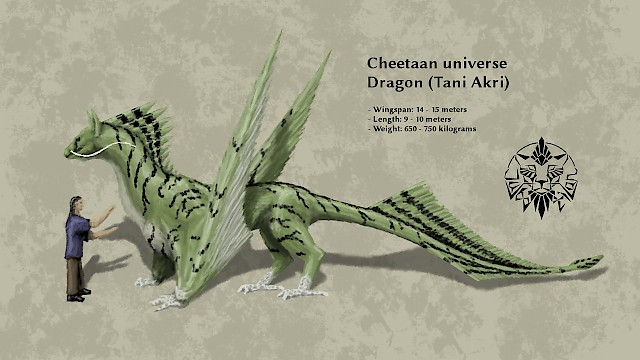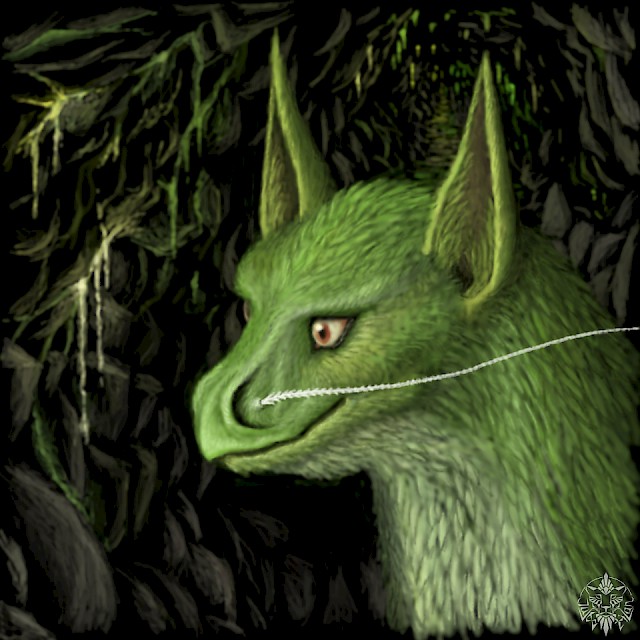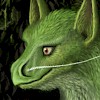The Tani Akri, the dragon in the Cheetaan Universe living primarily on the south pole of their planet. After many years I start to become somewhat content with their look and feel.
My main concern with this dragon thing is to make it actually plausible that it can fly, particularly that it can perform soaring flight. I did some research both after pterosaurs (of which the Quetzalcoatlus had a whopping 11 meters wingspan and could fly) and general aerodynamics (airplanes, especially gliders), revealing that most of the "conventional" dragon designs at best could only perform active flight (unless they are too big). For effortless soaring two very important things are required which a lot of dragons usually lack. One is appropriate control surfaces, notably an effective tail with horizontal surfaces to control pitch, similar to birds, or even Toothless' tail in How to Train Your Dragon (pterosaurs also had equivalents but on their hind legs). The other is to have a center of mass in front of the axis of the spread wings, so when the creature ceases to actively propel itself, it would pitch down instead of up. Not like there aren't other problems with dragons in this regard (for example there is a certain limit on how large a flapping wing construction can become due to the wingtips eventually nearing the speed of sound in performing certain maneuvers), but these are probably the most notable.
In my wyvern designs I try to retain the established dragon or wyvern form with relatively robust hindpart since I personally like this form more than how pterosaurs look (which certainly has a proper center of mass for the purpose of soaring) while attempting to get them airworthy. This Cheetaan Universe dragon during the years evolved a lot in subtle ways in this regard, particularly this is the first somewhat release-worthy drawing of him where I balanced him better, giving him a bulky long neck while considerably thinning out the rear. He got to have a quite fierce look by this modification.(especially if he was to be viewed from the front, the wing-arms splayed like lizard front legs), fitting the character.
The Dragon
The Tani Akri is one of the cheetaan races, living on their planet's southern pole. On the north live the cheetahs and the wolves, who built their peculiar civilization driven by genetic evolution. These three races are in a quite delicate relation, a balance in which neither dominates the other for various reasons. The role of dragons in this balance is keeping up an everlasting conflict which drives the evolution of this world, which is even understood by the participants accepting their roles.
The dragons fly, soar across the vast uninhabitable desert to the north and hunt. They kill the cheetahs for their genome, and occasionally take away the wolves to use them as hosts for newborn dragons. Some bits of details are necessary here to understand what this actually means in their world.
All the three Tani (the dragon, the cheetah and the wolf) share biological build, and that they are theoretically immortal. They don't evolve by the Earth way. They do have an equivalent of mating, but their construction is such that they don't raise children, but spread the merged genome within themselves, thus preserving the mind of the individual while evolving the body. Not entirely related to this, rather it is their method of building a civilization is that they have an entire neural construct to work with the genome, a brain under the shoulder, by which they can mutate viruses which they can use to shape their world. It holds more importance in forming their artificial constructs than the hands of the wolves. This brain can also sample genes and extract fragments of them to use for their good.
So come why the dragons kill the cheetahs. The cheetahs are the race with the most advanced evolution in this regard, they shape their world, and so their genes are quite valued, which they wouldn't just give away.
A similar reason is behind using the wolves as hosts. All the Tanis can infuse others with their genome, a horrid act in which the victim's body is slowly completely taken over, materializing a terrible illness as his body fights against the oppressor in which struggle his mind eventually dies. The result is a newborn, rising from terrible pain. Among the cheetahs and the wolves this is a last resort act in their ritual battles in which they prove their fitness, last resort on that term they only use it if their opponent lacks something fundamental or commits something outrageous. Cheetahs normally never fight wolves as due to their differences the former would always win. A wolf wouldn't even be capable to overwhelm a cheetahs body due to their superior genetic skills.
That's also the reason why a dragon has to kill a cheetah swiftly to gain fragments of his genome. The cheetah can release powerful viruses, things what could potentially destroy himself, if he faces death. The wolf is not capable of such deeds, so the dragon can take him anywhere safe, and take his time to infuse him until his body turns into that of a young dragon, carrying remnants of the former wolf's genome. If this dragon grows up and can prove himself, he may spread those in the dragon population.
Cheetahs and wolves have a needle under their tongue by which they infuse viruses with specific genome into whatever plant or creature they want to meddle with (the wolves mostly only use it among themselves, they can even heal each other in need if they are proficient in the art). In case of resorting to infuse another Tani with their genome, they can be relatively swift and throughout, completely killing the old being, the newborn as the mind reforms already receiving a somewhat settled body with little pain. The dragons however have no such needle, having a powerful impulse laser there. They battle with each other frequently, and infusion is more common among them than with the cheetahs or wolves.
When a dragon does that, he pins the victim down to make him unable to use his laser, then tears the shoulder open to drool into the wound, that alone taking a while as their skin is quite robust. By this he aims to overwhelm the genetic brain first to cripple the biological defenses, situated under the shoulder, but due to their large body, the head and hip areas holding the other two brains constituting a dragon's minds can still stand for much longer. Usually they don't even succeed in completely killing off the old being despite the days they spend in the process, repeatedly tearing up the wound to drool more viruses in the victim, resulting in a partial rebirth with fragments of memories from the past, and horrible pain.
There is hardly any dragon who doesn't remember a birth of horrid everlasting pain.
The power
The immortality of dragons is backed by a quite robust body. If there weren't the other dragons and the civilization of cheetaan, they would be outright indestructible, as their peculiar balance of conflict raised them (and among them, the cheetahs and wolves too) above anything previously imaginable by man.
The basis of the ecosystem is a biological application of electricity, occurring in both plant and animal life. They have no blood in the sense of Earth creatures. Their cells are more compact, lacking energy generators, and are capable to hibernate if they don't receive sufficient electrical current. They do have lungs, but those assist generation of electricity directly, which is then stored all around in the creature in biological capacitance. They neither need a steady supply of oxygen to live, and neither can really bleed out. They do have bodily fluid for various purposes, but their cells can endure its loss for a considerable while, they lack heart, and the Tani circulation is even capable to lock out injuries rather swiftly.
These properties make even less evolved bioelectric creatures far more dangerous to Earth beings than anything on our planet. They can be killed by guns, they die of internal injuries the same way like Earth animals, but due to the lack of blood and the different role of the lungs, there are far less possibilities to deliver a shot in them which would incapacitate them swiftly.
The Tani races however due to their nature are capable to reform themselves from any injury provided they are capable to receive power and resources for it. That's their most fundamental capability in the regard of working with the genome, the same power which can turn a wolf into a dragon can also heal a dragon no matter how crippled he is.
Dragons during the many hundred thousands years competing with the cheetahs and wolves grew large, and their body incorporated many capabilities uncommon even to those. Their lasers, both in the throat and the tailpin are old, their body has the lightest density yet with very robust carbon fiber reinforced bones (common to all to more or less degree), but the most peculiar is their sensory. They have a radar, and they even can emit radio waves themselves, by which they are capable to communicate with each other. They can at least sense many frequencies, and can locate their sources, and if they feel it necessary, they can even attempt to jam channels by own emission.
The same time if they want to stay hidden, they will stay hidden. Their green feathered hide serves them well in forests, and they cannot even be detected by emitted heat. They don't have a permanent body temperature, although have a certain minimum, however it remains well hidden under their robust insulation evolved to serve them in high altitudes. Of course this only passes until they start firing their laser which can considerably heats them up which they have to expel, but that's too late.
All these impressive capabilities in truth is merely their way of evolving: unlike human who builds an artificial civilization, they harness the power of biological evolution to craft the technology into themselves. Or that's what the cheetahs and wolves are doing which the dragons kept stealing to keep up with them.
The balance
By the wolves who excelled in the art of crafting by their hands, complementing the genetic skill of the cheetahs, eventually technological advancements came, slow like evolution, as it all seeped into genetic to create immerse biological constructs.
Dragons however in all ages weren't only hunters. They also lived on the north pole in peace with the civilized races, protecting them from their more ferocious kin, but the borders among them were always quite loose. They were feral but not without intelligence. Watching intently, they learned and keep learning the ways, and eventually that also spreads onto the south pole.
The balance remains, delicate, but lasting. The cheetahs and wolves know the dragons had their role in what they became, what they achieved, which wouldn't have happened without their pressing presence. They have doubts whether that was all necessary, why they endure, but they also admire the beast, it is kind of part of them, their world, just as all the other perils they have to face. The dragons, those becoming sentient, also recognize this, their role in the whole, and while keeping on the hunt, they respect the world they live in with all its creations.
There is also a faint foreboding among the cheetahs and wolves. The delicateness of the balance. While they advanced to such a technology level which could drive out feral dragons, they see that even if they wanted to do that, it wouldn't work out. They don't want to do it. It is part of the balance that they are both friends and enemies, there are many who bonded with dragons, and in an immortality, such bonds are powerful. But they see how much power is hidden in these apparently simple minded creatures, occasionally in a quite peculiar state of multiple personalities, how they have much larger brains than them, which are yet to truly awaken.
What if a subverting turmoil ever came to tip over this old balance?
Make a comment
Rules
- Please be polite (Leave all your trolls in their respective caves).
- If #1 fails, don't feed 'em. They bite.
- No links allowed. It won't pass. Neither chains. Use '(dot)' notation.
- Spam reeks.
- Text is (some day will be) formatted with Markdown.
- Your mail address is only visible to me: I understand you also don't like #4.
- The mail address you provide is also used to fetch your Gravatar.
- Danger! High voltage! Right between your "Post Comment" button and ground.
- Still want to comment? Go ahead! :)



Comments
No comments so far. Be the first to comment!